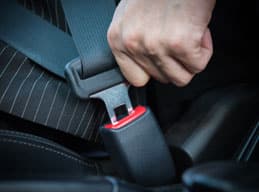Safety Shouldn’t Be Optional
Last updated Wednesday, November 20th, 2024

As originally published in Forum, a publication of the Connecticut Trial Lawyers Association, Fall 2021
The auto industry has held back on affordable safety technology – we should hold them accountable.
“No matter who you are or what you drive, everyone deserves to be safe.” This is what Toyota said in a 2010 People magazine ad specifically touting its accident avoidance technologies, adding that these features were installed “standard on every new vehicle.” Other automakers have made similar statements in promotional materials. Yet over the past decade or so the auto industry has intentionally slow-walked the deployment of readily available technology that would likely save thousands of lives and avoid tens of thousands of needless injuries every year. The time has come to hold the industry accountable.

Get Your FREE Case Review,
In Person or Virtually Online
Safety tech limited to premium packages
Forward Collision Avoidance Technology (FCAT), including Forward Collision Warning (FCW) and Autonomous Emergency Braking (AEB) systems, were developed and operational by the early to mid-2000s and made available in a select group of vehicles. By the early 2010s they were in widespread use, but largely remained a premium safety option that was only available as part of high cost packages on more expensive make and model lines. Even on those higher-end models, FCAT systems were only offered as part of much more expensive premium trim lines – a practice that continues to this day. Over the years, the marginal cost of FCAT systems to the manufacturer has dropped to well under $250 per vehicle.
These systems, when properly designed and tuned, can substantially mitigate or, in some cases, entirely avoid many of the most common vehicle collisions. For instance, a 2018 Insurance Institute for Highway Safety (IIHS) study found that FCW and AEB systems together reduced the risk of rear-end collisions with injuries by 64 percent. An earlier study by the same group found that, when FCAT included pedestrian and bicyclist detection, it was estimated that as many as 3,279 fatal and 37,000 injury-causing crashes could be prevented or mitigated each year. Likewise, in 2011, the National Highway Transportation Safety Agency (NHTSA) specifically declared that these technologies have been proven to have a safety benefit.
In addition, the agency added information about the presence of advanced crash avoidance technologies in vehicles to [the New Car Assessment Program,] NCAP. Technologies shown to have a safety benefit and that meet NHTSA’s performance criteria are recommended to consumers on NHTSA where all NCAP ratings are posted. The agency implemented these NCAP enhancements beginning with MY 2011.
It is important to keep in mind that unlike most safety features such as airbags and seatbelts, which are designed to protect the driver or other occupant of the vehicle, FCAT safety features principally protect unsuspecting members of the public who happen to be in the path of the vehicle and never had a choice whether to opt for enhanced safety features.

Get Your FREE Case Review,
In Person or Virtually Online
Safety systems should be standard
Numerous leading safety agencies and organizations have been urging the auto industry to speed up the rollout of this technology for years. Jason Levine, executive director of the Center for Auto Safety, describes the automakers’ practice of making safety optional as “playing roulette with the lives of consumers who cannot afford safety as a luxury.” “Safety shouldn’t be optional,” says William Wallace, a safety policy advocate for Consumer Reports. “These systems should be standard on every new car, not just luxury vehicles or more expensive trims, because even drivers and passengers who don’t know about these systems would benefit from having them.” In 2015, the National Transportation Safety Board formally recommended “for manufacturers to install forward collision avoidance systems as standard features on all newly manufactured passenger and commercial motor vehicles.”
In the past 12 months, Consumer Reports has pressed this issue through a print, radio, TV and social media safety advocacy campaign called the “Drive for Fairness,” which advances the common-sense view that these technologies shouldn’t only be for the rich. This statement from consumerreports.org says:
The auto industry has a history of resisting standard safety features in their vehicles – everything from seat belts to air bags were at one time opposed by automakers. Now, they’re at it again.
Advanced safety features exist right now that can save thousands of lives annually, but the auto industry isn’t following Consumer Reports’ recommendation that they be made standard in all vehicles. Instead, automakers are charging hundreds to thousands of dollars extra for them, or are including them only in luxury vehicles or as a part of premium packages.
Connecticut law supports a cause of action for refusing to install this technology as standard.
Under the risk-utility test, which will govern most product liability cases, a product is in a defective condition unreasonably dangerous to the consumer or user if…[a] reasonable alternative design was available that would have avoided or reduced the risk of harm and the absence of that alternative design renders the product unreasonably dangerous. In considering whether there is a reasonable alternative design, the jury must consider the feasibility of the alternative. Other relevant factors that a jury may consider include, but are not limited to, the ability of the alternative design to reduce the product’s danger without unreasonably impairing its usefulness, longevity, maintenance, and esthetics, without unreasonably increasing cost, and without creating other equal or greater risks of danger.
Several authorities have recognized that, under these standards, a readily available feasible safety system should not be held back as a premium option. “If an important safety feature can reasonably be integrated as a standard feature without diminishing a product’s utility, a manufacturer ordinarily should not be permitted to delegate the decision of whether to include the safety feature to purchasers likely to make improper cost-benefit safety decisions.” “The best tactic is for the manufacturer to include the safety device as standard equipment. If it chooses not to do so, it may be held liable because the manufacturer is held to be in the best position to do so.”
Given that these technologies are widely available in vehicles in the marketplace, the feasibility element is nearly conclusively established. Products marketed as safe should ordinarily include all the available safety features to protect the public from harm. When a manufacturer decides to make safety an option, it takes the chance that it will be liable for harm caused by putting profits before safety. As the technological feasibility of these critical safety features has been conclusively established, it is simply irrelevant that other manufacturers or minimum legal safety standards did not compel the installation of these safety features in all vehicles. The large majority of manufacturers have finally committed to voluntarily making this critical technology standard on most vehicles by September 1, 2022. While this should and could have been done years earlier, this will have a positive impact on any case brought going forward, since at the time of trial the technology will be widespread.
Although evidence of subsequent remedial measures is generally not admissible under Connecticut law in a negligence action on the issue of whether the defendant failed to exercise due care, it is admissible in a strict liability action on the issue of whether the product was defectively designed if the remedial repairs are related to the alleged design defect. “Subsequent change evidence may be highly probative of defectiveness because it provides a safer alternative against which to compare the allegedly defective product.”
Placing profit over safety
In Bonazzo v. Toyota Motor Corporation, et al., a Connecticut court joined only a handful of decisions across the county recognizing the validity of an action against an automobile manufacturer for its failure to install precollision warning systems. Judge Tyma rejected Toyota’s motion for summary judgment, holding that a genuine factual issue remained as to whether the vehicle was unreasonably dangerous to the consumer because of Toyota’s failure. As explained more fully:
Under the circumstances of the present action and based on Connecticut product liability law, there remain general issues of material fact as to whether Toyota should have integrated as a standard feature the existing FCW and AEB collision warning systems in Graham’s Corolla vehicle as reasonable minds could conclude that such installation was less costly and risky than the foreseeability of harm caused by the failure to install those systems. There is no dispute that those collision warning systems existed at that time that Graham purchased his vehicle, that Toyota was installing them in certain luxury vehicles, and that the technology became standard on most Toyota and Lexus vehicles sold in the United States in the beginning of 2017.
Judge Tyma’s ruling provides valuable precedent for establishing liability in similar cases.
This is not to say such cases are easy. Auto manufacturers are notoriously aggressive in defending product liability claims, making them very expensive to pursue. In the Bonazzo case, this entailed substantial expert expenses. The defendants will go to great lengths to dispute causation, even claiming – incredibly – that these safety systems don’t really work.
The industry has been delaying widespread implementation of this life-saving technology for years, despite its clear feasibility, in the classic example of profit over safety. Safety shouldn’t be optional, particularly when the principal beneficiaries of these technologies are ordinary members of the public who happen to have the misfortune of being in the path of one of these vehicles. These cases should be pursued to hold the industry accountable.

